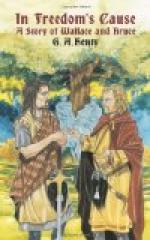“You will see on this chart, which I have drawn out, the lines by which the principal competitors — for there were nigh upon a score of them — claimed the throne.
“Before the death of the maid, King Edward had proposed a marriage between her and his young son, and his ambassadors met the Scottish commissioners at Brigham, near Kelso, and on the 18th of July, 1290, the treaty was concluded. It contained, besides the provisions of the marriage, clauses for the personal freedom of Margaret should she survive her husband; for the reversion of the crown failing her issue; for protection of the rights, laws, and liberties of Scotland; the freedom of the church; the privileges of crown vassals; the independence of the courts; the preservation of all charters and natural muniments; and the holding of parliaments only within Scotland; and specially provided that no vassal should be compelled to go forth of Scotland for the purpose of performing homage or fealty; and that no native of Scotland should for any cause whatever be compelled to answer, for any breach of covenant or from crime committed, out of the kingdom.
“Thus you see, my boy, that King Edward at this time fully recognized the perfect independence of Scotland, and raised no claim to any suzerainty over it. Indeed, by Article I it was stipulated that the rights, laws, liberties, and customs of Scotland should remain for ever entire and inviolable throughout the whole realm and its marches; and by Article V that the Kingdom of Scotland shall remain separate and divided from England, free in itself, and without subjection, according to its right boundaries and marches, as heretofore.
“King Edward, however, artfully inserted a salvo, `saving the rights of the King of England and of all others which before the date of this treaty belong to him or any of them in the marches or elsewhere.’ The Scottish lords raised no objection to the insertion of this salvo, seeing that it was of general purport, and that Edward possessed no rights in Scotland, nor had any ever been asserted by his predecessors — Scotland being a kingdom in itself equal to its neighbour — and that neither William the Norman nor any of his successors attempted to set forward any claims to authority beyond the Border.
“No sooner was the treaty signed than Edward, without warrant or excuse, appointed Anthony Beck, the warlike Bishop of Durham, Lieutenant of Scotland, in the name of the yet unmarried pair; and finding that this was not resented, he demanded that all the places of strength in the kingdom should be delivered to him. This demand was not, however, complied with, and the matter was still pending when the Maid of Norway died. The three principal competitors — Bruce, Baliol, and Comyn — and their friends, at once began to arm; but William Fraser, Bishop of St. Andrews, a friend of Baliol, wrote to King Edward suggesting that he should act as arbitrator, and more than hinting that if he chose Baliol he would find him submissive in all things to his wishes. Edward jumped at the proposal, and thereupon issued summonses to the barons of the northern counties to meet him at Norham on the 3d of June; and a mandate was issued to the sheriffs of Northumberland, Cumberland, Westmoreland, York, and Lancaster, to assemble the feudal array at the same rendezvous.




